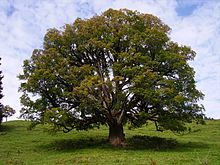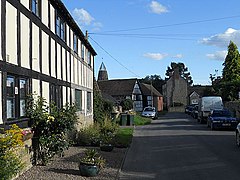정조식물
Spermatophyte| 종자 식물 시간 범위: | |
|---|---|
 | |
| 스코틀랜드 소나무, 피너스 실베스트리스, 피노피타의 일원 | |
 | |
| 유디코트의 일원인 아카모레 단풍나무, 에이서 유사 플라타누스 | |
| 과학적 분류 | |
| 왕국: | 플랜태 |
| Clade: | 기관지 식물 |
| Clade: | 정조식물 |
| 디비전 | |
| 동의어 | |
| |
A spermatophyte (lit. 'seed-bearing plants'; from Ancient Greek σπέρματος (spérmatos) 'seed', and φυτόν (phytón) 'plant'), also known as phanerogam (taxon Phanerogamae) or phaenogam (taxon Phaenogamae), is any plant that produces seeds, hence the alternative name seed plant.정자식물은 태생식물이나 육지식물의 하위 집합이다.
phanerogames 또는 phanerogamae라는 용어는 "보여진다"는 뜻의 그리스어 αανεphphphphph (phaneros)에서 유래했으며, cryptogamae (고대 그리스어 ρππhiddenhiddenhiddenhiddenhiddenhiddenhiddenhiddenhiddenhiddenhiddenhiddenhiddenhiddenhiddenhiddenhidden)와 "결혼하다"라는 뜻의 접미사 αμέέέέgam thegamgamgamgamgamgam the the the the the the the the the the the the the the the"" the the the the the the the the the the the the the the the the the the the the the the the the the이러한 용어들은 숨겨진 성기를 가진 식물들과 눈에 보이는 성기를 가진 식물들을 구별했다.
묘사
현존하는 정조식물들은 5개 부문을 형성하며, 그 중 처음 4개는 전통적으로 나체식물로서 분류된다.나체식물들은 닫혀있지 않은 "벌거벗은 씨앗"[1]: 172 을 가지고 있다.
- 소철, 소철, 아열대 및 열대 식물군,
- 은행나무속 나무 한 종을 포함하는 은행나무는
- 침엽수인 피노피타(Pinophyta)는 원추형의 나무와 관목이다.
- 그네토피타, 그네토피식물, 에페드라, 그네툼, 그리고 웰위치아에 속하는 다양한 목질 식물.
현존하는 다섯 번째 분류는 가장 크고 다양한 정조식물군인 앤지오스퍼름(Angiosperms) 또는 목련식물(Magnoliophytes)이라고도 하는 꽃식물이다.
화석 기록에는 위에 열거된 5개의 살아있는 분류군 외에도 종자 식물의 많은 멸종 분류군의 증거가 포함되어 있다.
- 소위 "씨앗 양치류"라고 불리는 프테리도스페르매는 육지 식물의 가장 성공적인 그룹 중 하나였으며, 고생대 말기에는 씨앗 양치류가 지배하는 숲이 널리 퍼져 있었다.
- Glossopteris는 페름기 동안 고대 남부 초대륙 곤드와나에서 가장 두드러진 나무속이었다.
트라이아스기 시대까지, 종자 양치류는 생태학적 중요성이 감소했고, 현대의 나체배아 그룹의 대표자들은 혈관배아가 방사된 백악기 말기에 풍부하고 우세했다.
진화사
종자식물의 조상에서 일어난 전체 게놈 복제 사건은 약 3억 1,900만 [2]년 전에 일어났다.이것은 씨앗 식물의 기원을 초래하는 일련의 진화적 변화를 야기했다.
벨기에에서 온 종자식물의 중간 데본기(3억8천500만년) 전조가 초기 종자식물의 약 2천만년 전에 확인되었다.작고 반지름 대칭인 룬카리아는 큐풀로 둘러싸인 관상 메가스포리움이다.메가스포리엄은 복엽 피막 위로 돌출된 개방되지 않은 원위부를 가지고 있다.이 확장은 친기성(바람) 수분 작용이 있었던 것으로 의심된다.Runcaria는 시드로 이어지는 캐릭터 획득의 순서를 새롭게 조명합니다.룬카리아는 단단한 씨앗 껍질과 꽃가루를 [3]씨앗으로 이끄는 시스템을 제외하고 씨앗 식물의 모든 특성을 가지고 있습니다.
관계와 명명법
씨앗을 가진 식물은 혈관 식물(기관식물)의 아계층으로 전통적으로 앵지오줌, 즉 현화 식물과 나체오줌으로 나뉘었는데, 나체오줌은 견과류, 소철, 은행, 침엽수를 포함한다.오래된 형태학 연구는 특히 혈관 요소에 기초해 신생 식물과 혈관 배유 [4]사이의 밀접한 관계를 믿었다.그러나 분자 연구(그리고 최근의 형태학[5][6] 및 화석[7] 논문)는 일반적으로 침엽수 안에 또는 근처에 편생식물이 있는 나체배엽의 분열을 보여주고 있다.예를 들어 일반적으로 제안된 관계 집합 중 하나는 gne-pine 가설로 알려져 있으며 다음과 같습니다.[8][9][10]
| 안지오스페름(식물) | ||||||||||||||||||||||
| 나체파마 |
| |||||||||||||||||||||
그러나 이러한 그룹 간의 관계가 [4][12]해결되었다고 간주해서는 안 된다.
다른 분류는 모든 종묘를 단일 중분류로 분류하고, 5개 그룹에 대한 분류를 포함한다.
좀 더 현대적인 분류는 이들 그룹을 별도의 분류로 분류한다(때로는 Superdivision Spermatophyta 아래).
Anderson, Anderson, Cleal[14] 2007의 식물 분류군 저자와 함께 Novikov & Barabash-Krasni 2015의[13] 연구에 기초한 정자생물의 대체 계통학.
|
할당되지 않은 정자:[citation needed]
- § Avatiaceae Anderson & Anderson 2003
- ①악셀로디옵시다 앤더슨 & 앤더슨
- § Alexiales Anderson & Anderson 2003
- § Hamshawivales Anderson & Anderson 2003
- § Hexapterospermales Doweld 2001
- § Hlatimbiales Anderson & Anderson 2003
- § Matatitellales Anderson & Anderson 2003
- § Petriellales Taylor et al. 1994
- § Arberiopsida Doweld 2001
- § Czekanowskiales Taylor et al. 2008
- ①이란 E. Taylor et al.
- Vojnovskyales E. Taylor et al.
- ①허마노피테일즈 E. Taylor et al.
- ② 디르호팔로스타키아과 E. Taylor et al.
레퍼런스
- ^ Judd, Walter S.; Campbell, Christopher S.; Kellogg, Elizabeth A.; Stevens, Peter F.; Donoghue, Michael J. (2002). Plant systematics, a phylogenetic approach (2 ed.). Sunderland MA, USA: Sinauer Associates Inc. ISBN 0-87893-403-0.
- ^ Jiao Y, Wickett NJ, Ayampalayam S, Chanderbali AS, Landherr L, Ralph PE, Tomsho LP, Hu Y, Liang H, Soltis PS, Soltis DE, Clifton SW, Schlarbaum SE, Schuster Ha, Ma, S.자연.
- ^ "Science Magazine". Runcaria, a Middle Devonian Seed Plant Precursor. American Association for the Advancement of Science. 2011. Archived from the original on February 24, 2011. Retrieved March 22, 2011.
- ^ a b Palmer, Jeffrey D.; Soltis, Douglas E.; Chase, Mark W. (2004). "The plant tree of life: an overview and some points of view". American Journal of Botany. 91 (10): 1437–1445. doi:10.3732/ajb.91.10.1437. PMID 21652302.
- ^ James A. Doyle (January 2006). "Seed ferns and the origin of angiosperms". The Journal of the Torrey Botanical Society. 133 (1): 169–209. doi:10.3159/1095-5674(2006)133[169:SFATOO]2.0.CO;2. ISSN 1095-5674.
- ^ Coiro, Mario; Chomicki, Guillaume; Doyle, James A. (n.d.). "Experimental signal dissection and method sensitivity analyses reaffirm the potential of fossils and morphology in the resolution of the relationship of angiosperms and Gnetales". Paleobiology. 44 (3): 490–510. doi:10.1017/pab.2018.23. ISSN 0094-8373. S2CID 91488394.
- ^ Zi-Qiang Wang (2004). "A New Permian Gnetalean Cone as Fossil Evidence for Supporting Current Molecular Phylogeny". Annals of Botany. 94 (2): 281–288. doi:10.1093/aob/mch138. PMC 4242163. PMID 15229124.
- ^ Chaw, Shu-Miaw; Parkinson, Christopher L.; Cheng, Yuchang; Vincent, Thomas M.; Palmer, Jeffrey D. (2000). "Seed plant phylogeny inferred from all three plant genomes: Monophyly of extant gymnosperms and origin of Gnetales from conifers". Proceedings of the National Academy of Sciences. 97 (8): 4086–4091. Bibcode:2000PNAS...97.4086C. doi:10.1073/pnas.97.8.4086. PMC 18157. PMID 10760277.
- ^ Bowe, L. M.; Michelle, L.; Coat, Gwénaële; Claude (2000). "Phylogeny of seed plants based on all three genomic compartments: Extant gymnosperms are monophyletic and Gnetales' closest relatives are conifers". Proceedings of the National Academy of Sciences. 97 (8): 4092–4097. Bibcode:2000PNAS...97.4092B. doi:10.1073/pnas.97.8.4092. PMC 18159. PMID 10760278.
- ^ Soltis, Douglas E.; Soltis, Pamela S.; Zanis, Michael J. (2002). "Phylogeny of seed plants based on evidence from eight genes". American Journal of Botany. 89 (10): 1670–1681. doi:10.3732/ajb.89.10.1670. PMID 21665594.
- ^ Chung-Shien Wu, Ya-Nan Wang, Shu-Mei Liu and Shu-Miaw Chaw (2007). "Chloroplast Genome (cpDNA) of Cycas taitungensis and 56 cp Protein-Coding Genes of Gnetum parvifolium: Insights into cpDNA Evolution and Phylogeny of Extant Seed Plants". Molecular Biology and Evolution. 24 (6): 1366–1379. doi:10.1093/molbev/msm059. PMID 17383970.
{{cite journal}}: CS1 maint: 여러 이름: 작성자 목록(링크) - ^ Won, Hyosig; Renner, Susanne (August 2006). "Dating Dispersal and Radiation in the Gymnosperm Gnetum (Gnetales)—Clock Calibration When Outgroup Relationships Are Uncertain". Systematic Biology. 55 (4): 610–622. doi:10.1080/10635150600812619. PMID 16969937.
- ^ Novíkov & Barabaš-Krasni (2015). Modern plant systematics. Liga-Pres. p. 685. doi:10.13140/RG.2.1.4745.6164. ISBN 978-966-397-276-3.
- ^ Anderson, Anderson & Cleal (2007). Brief history of the gymnosperms: classification, biodiversity, phytogeography and ecology. Strelitzia. Vol. 20. SANBI. p. 280. ISBN 978-1-919976-39-6.
참고 문헌
- Kron, Kathleen A; Chase, Mark W (2005-11-17). Molecular systematics and seed plant phylogeny: a summary of a parsimony analysis of rbcL sequence data. pp. 243–252. ISBN 9780521022897., Gibbs et al(1995)에서
- Gibbs, Adrian J.; Calisher, Charles H.; García-Arenal, Fernando, eds. (1995). Molecular basis of virus evolution. Cambridge: Cambridge University Press. ISBN 9780521022897.
- Soltis, D. E.; Soltis, P. S.; Zanis, M. J. (1 October 2002). "Phylogeny of seed plants based on evidence from eight genes". American Journal of Botany. 89 (10): 1670–1681. doi:10.3732/ajb.89.10.1670. PMID 21665594. S2CID 2444652.


